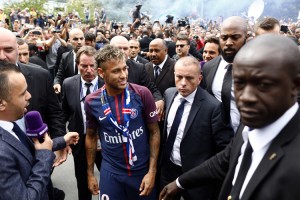Money in World Soccer
November 22, 2017
In May 2017, London’s powerhouse soccer club Chelsea won the English Premier League (EPL), arguably the world’s best professional soccer league. For Chelsea, led by Belgian superstar Eden Hazard and no stranger to success, it was its sixth English title. On June 3, Spanish side Real Madrid defeated Italy’s Juventus 4-1 to win the Union of European Football Associations (UEFA) Champions League, the world’s top annual soccer tournament. Real Madrid, led by superstars Cristiano Ronaldo, Gareth Bale, and Karim Benzema, won its second-straight European championship and record 12th overall. The soccer year was dedicated to familiar favorites, but it was individual stars who stole the headlines—and the cash.

Brazilian soccer star Neymar and his bodyguards wade through fans and media to attend a press conference officially announcing his move from Barcelona to Paris Saint-Germain on Aug. 4, 2017, in Paris, France. Credit: © Mehdi Taamallah, NurPhoto/Getty Images
The money year began in China, where the Chinese Super League (CSL) has dangled oodles of yuan (the nation’s currency) to lure players away from better known and more competitive leagues elsewhere. In January, Argentine striker Carlos Tevez joined Shanghai Greenland Shenhua. His new salary? Roughly $42 million per year, or more than $800,000 per week—and more than 20 times the salary paid by his previous club, Buenos Aires’s Boca Juniors. Nigerian John Obi Mikel and Brazilians Alexandre Pato and the mononymous Oscar were among the other stars who followed the money to China. Managers, too, were chasing yuan signs (¥): 12 of the CSL’s 16 teams are currently led by coaches from other countries. Notable among them are Brazil’s World Cup-winning coach Luiz Scolari and Chile’s Manuel Pellegrini, who guided Manchester City to an EPL championship in 2014. Italian Fabio Capello leads Jiangsu Suning; his compatriot, Fabio Cannavaro, manages Tianjin Quanjian.
As more and more talent took the fast boat to China, the Chinese government counteracted the growing trend in late May 2017 by introducing a heavy import tax on clubs—purportedly to encourage the development of domestic talent. The nation’s “100 percent tax” means that every yuan a club spends on a foreign player must be matched by a yuan paid to the Chinese Football Development Foundation. The tax effectively doubles the price for foreign players, somewhat lessening the shock value of CSL salaries. The Chinese Football Association (CFA) has taken protective steps too by limiting clubs to a maximum of three non-Chinese players.
The CSL was soon upstaged, however, by colossal transfer dealings in Europe, where the average EPL salary is $3 million per year. In July, English right back Kyle Walker took $60 million to move from Tottenham Hotspur to Manchester City—a record topped days later by French left back Benjamin Mendy’s $70-million move from Monaco to Manchester City. (Teams in Europe pay a transfer fee, which amounts to buying out the player’s existing contract, while also adding the cost of a new contract.) London’s Arsenal bought French striker Alexandre Lacazette from Lyon for $60 million; Chelsea signed Spanish striker Álvaro Morata for $80 million; and Manchester United bought Belgian striker Romelu Lukaku from Everton for $100 million. During the hot transfer season of July and August, EPL clubs spent a total of $1.8 billion on new players, an amount roughly equal to the gross domestic product of the Italian republic of San Marino.
The year’s biggest jaw-dropper hit in early August, when Brazilian star Neymar confirmed wild rumors that he was leaving Spain’s Barcelona for Paris Saint-Germain in France. The price? $263 million. Barcelona then promptly spent $125 million on French forward Ousmane Dembélé.


